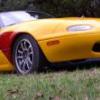Sometimes less cash outlay equals less favorable performance.
And sometimes more money is just more money. There's plenty of evidence that the AEM / UEGO system is a quality system, its not some fly-by-night also-ran. Personally, I have plenty of side-by-side data comparisons between my AEM and dyno AFR to show that the AEM is accurate. The ultimate long term accuracy is driven by the sensor, its placement and orientation, and how long you wait between replacing it.
To the OP.
As Chris said, the easy button will be the AIM LC1, because you just install and connect it up. If you aren't put off by a little DIY, then....
The AEM gage has a 0-5V output. It comes with a long harness, and a signal/reference pair of wires for the 0-5V output. The output is setup to output AFR on the analog output.
0.5 Vdc = 8.5:1 AFR
4.5Vdc = 18.0:1 AFR
I don't have an AIM Daq system, mine is a Racepak. But, the idea will be the same. I have several analog inputs in my Daq. So, I wire the white/brown pair to an open analog input, and then program my Daq system according to the data above. I think I ultimately made a couple tweaks to the transfer function to account for offset/gain errors in my Daq that caused logged data to be slightly different from the gage readout.
As I said above, I've had numerous occasions to compare the AEM gage output to a secondary Wideband (on the Dyno) over the years. They have always agreed within about 0.2 AFR.
However, it is necessary to replace the O2 sensor, periodically (every 1-2 years).
Finally, note that I have a 1.6L. I don't know that's particularly relevant in this conversation, though.
I should also note, that I'm an computer and electrical engineer with 25 years of experience designing analog circuits, and data acquisition systems for industrial, military, and avionic applications. So, I might not be the average Joe. That said, what I described above isn't rocket-surgery. If you aren't color blind and can read a PDF, maybe can solder or use a crimping tool....it should be straightforward.




 Sign In
Sign In Create Account
Create Account





 Back to top
Back to top Report
Report



















